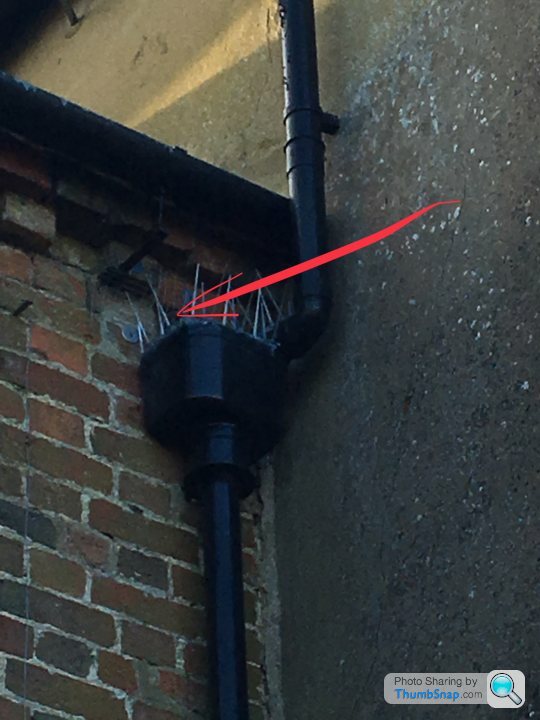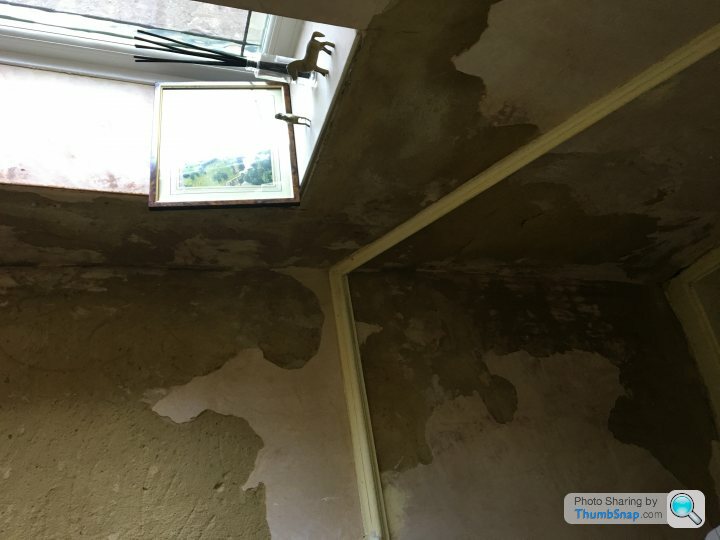Advice for repairing a damp wall in an old house
Discussion
I'm looking for some advice to help my Mum and Dad out. They live in an old house and one of the rooms has a damp external wall. The damp is coming in from an external hopper which takes water from an internal gully between two pitches. So the outside brick gets damp, and is north facing so never really dries. The walls are probably 2 feet deep so the whole wall must be damp. Historically the internal walls probably had a lime plaster or something breathable but sometime in the last 50 years it has been skimmed with some new plaster that doesn't look like it breathes in the same way. On top of this plaster is wood chip which has had many different coats of paint. Anyway, the plaster has blown and the wood chip paper is so damp it now just peels straight off. We have stripped off the damp paper, and pulled off all the loose plaster. Under the plaster is sand & cement which is kind of damp looking but doesn't really feel that damp.
So... the question is... what do we do next! We are worried that using a stain block on the sand and cement will just move the problem to the next spot. Equally we don't want to strip all the wood chip off because its a big room and 95% of it is fine. Is there a way to plaster the knackered bits and repaper it that wouldn't be inviting a repeat of the same problems in a few months time? Any ideas welcome!
Thanks in advance for any pointers.
Cheers, Klive.
So... the question is... what do we do next! We are worried that using a stain block on the sand and cement will just move the problem to the next spot. Equally we don't want to strip all the wood chip off because its a big room and 95% of it is fine. Is there a way to plaster the knackered bits and repaper it that wouldn't be inviting a repeat of the same problems in a few months time? Any ideas welcome!
Thanks in advance for any pointers.
Cheers, Klive.
Thanks for the replies guys.
The hopper and downpipe etc are all fine, the problem is that they get blocked. In the past birds have nested in the hopper but we recently covered it in all manner of medieval spikes to put a stop to this. That will hopefully help but I think the reality is that fixing the problem is going to be tough. The internal gully is a complete PITA to access and it picks up the rainfall from two pretty big pitched roofs. What happens is that when there is a real downpour, all the moss, bird crap, twigs etc are pushed into the gully and then onto the hopper. Eventually, whatever we do, the gully and the hopper both have a day where they overflow. The lesser of two evils is to have the crap pushed into the hopper because at least that is accessible on ladders. The gully on the other hand is a major job to access. So.. other than doing our best to keep the hopper and gully as clear as possible.. we have accepted that this is a losing battle.
So with that in mind, whats the best way of doing the internal plaster and paperwork, with the knowledge that this wall is probably going to get wet again?
The hopper and downpipe etc are all fine, the problem is that they get blocked. In the past birds have nested in the hopper but we recently covered it in all manner of medieval spikes to put a stop to this. That will hopefully help but I think the reality is that fixing the problem is going to be tough. The internal gully is a complete PITA to access and it picks up the rainfall from two pretty big pitched roofs. What happens is that when there is a real downpour, all the moss, bird crap, twigs etc are pushed into the gully and then onto the hopper. Eventually, whatever we do, the gully and the hopper both have a day where they overflow. The lesser of two evils is to have the crap pushed into the hopper because at least that is accessible on ladders. The gully on the other hand is a major job to access. So.. other than doing our best to keep the hopper and gully as clear as possible.. we have accepted that this is a losing battle.
So with that in mind, whats the best way of doing the internal plaster and paperwork, with the knowledge that this wall is probably going to get wet again?
Jonesy123 - a spout in the hopper is a great shout. Will give that a try. It will be a good early warning system if nothing else.
Wolfsonic, we have already upgraded the hopper a few times and its pretty big now with a 4" downpipe!
So if we can get this damp issue resolved, which will be awesome, is there any particular type of pva, or any type of plaster that we should use?
Wolfsonic, we have already upgraded the hopper a few times and its pretty big now with a 4" downpipe!
So if we can get this damp issue resolved, which will be awesome, is there any particular type of pva, or any type of plaster that we should use?
Thanks everyone for all the input. You have collectively opened our eyes to possible solutions!
The copper is a nice idea so will look into that and see if it helps the moss problem. We will still have the general debris from the birds washing into the gully but as long as it makes it's way to the newly spouted hopper.. we should know when it is close to overflowing. Moving the downpipe and hopper a bit further from the wall is also sensible. We'll do those bits and then watch and see. The wall is exposed internally so we will hopefully see if its been sorted or not.
Re the cherry pickers.. unfortunately its not so easy. The front is too high and you can't get close enough to the building, and the back has no access. It's not impossible to get to but its not something you want to have to do more than once a year. This bit of the building is awkward because its where the original house meets a later addition, and in those days it was probably more socially acceptable to send a small child up to clean it out.
Couple of pics - the red arrow points to where the internal gully emerges:

Internal wall without wood chip and blown plaster (apologies, not sure why they are on their side):


Thanks again everyone.
Klive
The copper is a nice idea so will look into that and see if it helps the moss problem. We will still have the general debris from the birds washing into the gully but as long as it makes it's way to the newly spouted hopper.. we should know when it is close to overflowing. Moving the downpipe and hopper a bit further from the wall is also sensible. We'll do those bits and then watch and see. The wall is exposed internally so we will hopefully see if its been sorted or not.
Re the cherry pickers.. unfortunately its not so easy. The front is too high and you can't get close enough to the building, and the back has no access. It's not impossible to get to but its not something you want to have to do more than once a year. This bit of the building is awkward because its where the original house meets a later addition, and in those days it was probably more socially acceptable to send a small child up to clean it out.
Couple of pics - the red arrow points to where the internal gully emerges:

Internal wall without wood chip and blown plaster (apologies, not sure why they are on their side):


Thanks again everyone.
Klive
Gassing Station | Homes, Gardens and DIY | Top of Page | What's New | My Stuff



